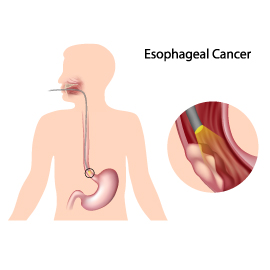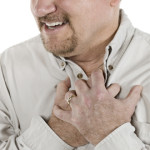
Esophageal cancer begins forming in the cells that line the inside of the esophagus, and while it can occur anywhere along the length of the esophagus, it most often occurs in the lower portion. gastroesophageal reflux disease or GERD is a potential cause of esophageal cancer.
Types of Esophageal Cancer
Cancer of the esophagus can occur in two forms.
- Adenocarcinomas. This type is associated more with gastroesophageal reflux disease (GERD) and Barrett’s esophagus. This form of esophageal cancer usually occurs in the lower portion of the esophagus.
- Squamous cell carcinomas. This type is similar to head and neck cancer in both appearance and that it’s associated with tobacco and alcohol. This form usually occurs in the upper portion of the esophagus.
Symptoms and Warning Signs
- Difficulty swallowing
- Constant choking when you eat
- Indigestion
- Heartburn
- Frequent coughing fits, or periods of hoarseness
- Chest pain or pressure
Risk Factors for Esophageal Cancer
There are several risk factors that may increase an individual’s chances of developing cancer of the esophagus. These include:
- GERD
- Smoking or tobacco use
- Heavy alcohol consumption
- Barrett’s esophagus
- Obesity
- Sex (esophageal cancer is more common in men)
- Race (esophageal cancer is more common in African Americans)
- Age (esophageal cancer is more common in people over 65)
Diagnosis
Methods of diagnosing esophageal cancer are similar to those used to diagnose GERD. They include an endoscopy, biopsy and barium swallow test. After diagnosis, your doctor will perform a screening to determine the stage of the esophageal cancer.
Stages
Esophageal cancer exists in four stages (I through IV), and the higher the stage, the more advanced the cancer is.
- Stage 0: Cell abnormalities, though not yet cancer, in the esophageal lining.
- Stage I: Cancer cells located in the esophageal lining.
- Stage II: Cancer cells have reached the layer of muscles on the outside of the esophagus. As well, the cancer may have spread to nearby lymph nodes.
- Stage III: Cancer cells have reached deeper into the connective tissue wall. At this stage, the cancer cells may have spread to a surrounding organ.
- Stage IV: Cancer cells have spread to organs in the body that are far from the esophagus.
Treatment
Depending on what stage the esophageal cancer is in, a doctor may recommend particular treatment options.
- Stage 0: Surgery, photodynamic therapy, radiofrequency ablation or endoscopic mucosal resection.
- Stage I, II and III: Surgery, chemotherapy and radiation trials or clinical trials of new therapies.
- Stage IV: Chemotherapy, radiation, laser therapy, clinical trials or electrocoagulation therapy. This stage’s treatment is palliative. That is, it’s meant to relieve the pain associated with the cancer. Patients who are in advanced stages of cancer or near the end of their lives receive these forms of treatments.
Generally, there are no symptoms during the early stages of cancer of the esophagus, so it’s important to make an appointment with your doctor if you experience any reoccurring signs or symptoms, especially if you have any of its risk factors.



